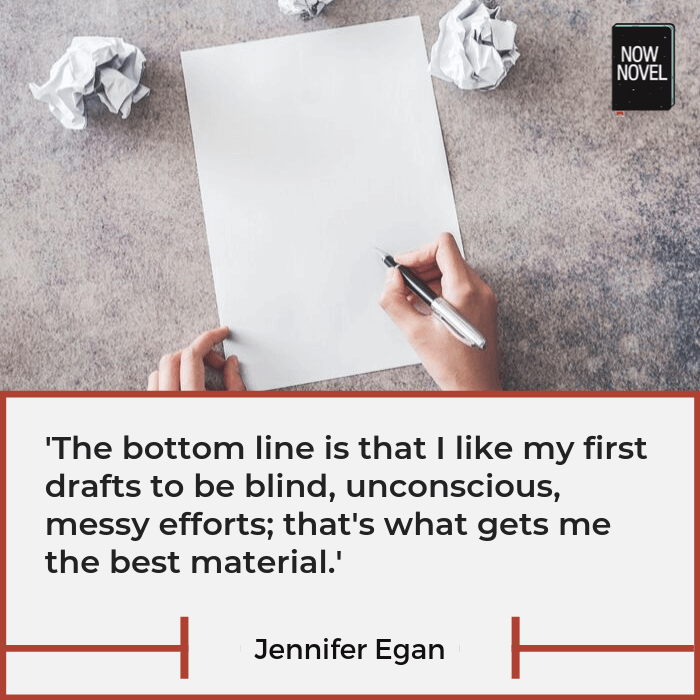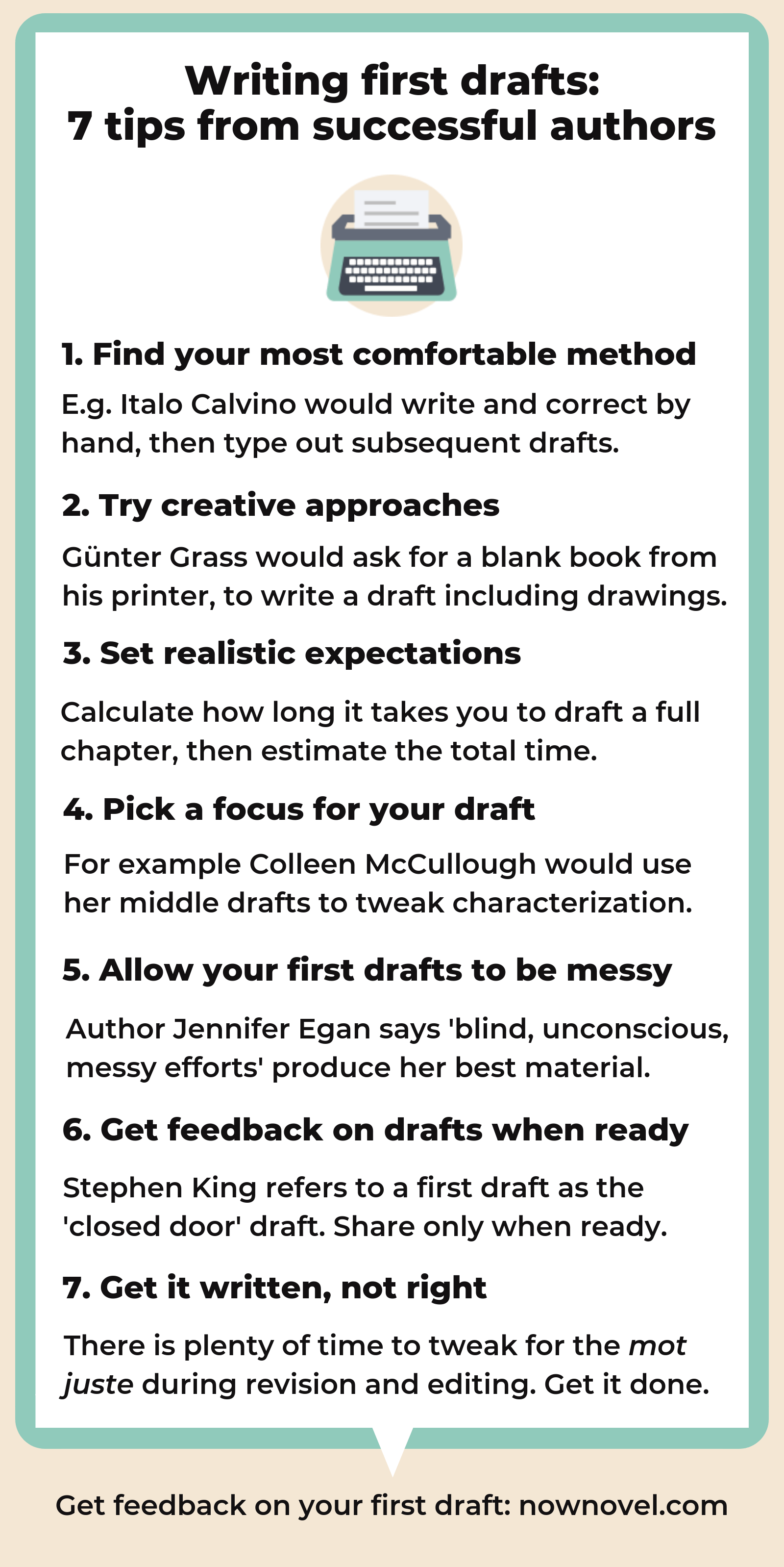How Do You Know When Your First Draft Is Done
Writing first drafts is a stage of the writing procedure many authors detect daunting. Read 7 tips for first drafts from writers and get your first draft done:
ane. Discover your most comfortable method
There'south nounmarriedapproach to writing a first typhoon. Accept, for example, the highly specific process Italo Calvino describes to The Paris Review:
My pages are e'er covered with canceling lines and revisions. In that location was a time when I fabricated a number of handwritten drafts. Now, after the first typhoon, written by hand and completely scrawled over, I showtime typing it out, deciphering as I go. When I finally reread the typescript, I discover an entirely different text that I oft revise further. And then I brand more corrections. On each folio I try beginning to make my corrections with a typewriter; I then correct some more by mitt.
Italo Calvino, in 'The Art of Fiction No. 130', interviewed by William Weaver, Damien Pettigrew. Available here.
Many authors adoptnotto draft like Calvino, preferring to leave corrections and revisions until the entire draft is complete.
Which method you cull depends on what you feel comfortable with.
Does reviewing and making corrections as you go discourage you, or make you uncertainty what you've written? Turn your font colour to match your page groundwork (typically, white) then that you lot tin can'tedit equally yous become. Change the colour back only earlier saving your document until the next writing session.
This is one elementary method to force yourself to keep going rather than correcting continuously.
ii. Effort creative approaches to capture ideas
A outset typhoon gives you lot nifty freedom to effort other means of organizing and teasing out ideas.
Vladimir Nabokov is famous for writing drafts on numbered index cards he could so move around and reshuffle into unlike sequences. This helped him unlock different pathways and combinations of scenes for the narrative.
Günter Grass, the German writer, poet, illustrator and graphic artist described cartoon as integral to writing his start drafts:
The first version of The Rat is in a large volume of unlined paper, which I got from my printer. When one of my books is about to be published I e'er ask for one blind copy with bare pages to employ for the next manuscript. So, these days the first version is written by paw with drawings then the second and the third are done on a typewriter. I have never finished a book without writing three versions. Usually in that location are four with many corrections.
Günter Grass in 'The Art of Fiction no. 124', interviewed by Elizabeth Gaffney, bachelor hither.
Combine fatigued sketches timelines, character profiles, setting summaries and any other process piece of work yous need to utilize to brand the pieces of your story come together in your mind'due south eye.
[You lot tin as well brainstorm and develop ideas in easy steps in our story dashboard.]

three. Set realistic expectations
It's difficult to keep soldiering through a process that takes much longer than you expect because the chore ahead may start to feel overwhelming.
Although challenges to write a volume in thirty days like NaNoWriMo are fun, the truth is the average first draft takes much longer. Says Gillian Flynn (author ofGone Girl):
I go actually tense during the first typhoon. Actually tense. That's non great for my family, because the outset typhoon usually takes virtually a year.
Gillian Flynn, 'The Gone Girl phenomenon: Gillian Flynn speaks out' for The Guardian.
To go on expectations of yourself you lot tin can encounter while y'all draft, set a timer. Time each writing session until you lot finish a chapter's typhoon. Accept the word count and the time it took to attain, and multiply this to get an estimate of how long it would take to accomplish 80, 000 words (the gauge word count of a total-length novel).
Checking in on your process similar this helps to keep realistic expectations which in plough helps you create realistic goals you are capable of reaching.
four. Selection a focus for your typhoon
Drafting with purpose is helpful to maintain the feeling that you lot are getting closer to the stop line.
Choosing a focus for your draft (whether it's solving a single character's arc or getting your research correct) volition help make the work yous exercise on your first draft valuable. Australian writer Colleen McCullough (whoseThe Thorn Birds sold over 30 million copies) described choosing a focus for her drafts thus:
Once I've got the first typhoon downwards on paper then I do five or six more drafts, the last two of which will be polishing drafts. The ones in between volition flesh out the characters and maybe I'll check my enquiry.
Colleen McCullough, quoted by Writer's Write, available here.
5. Let your first drafts to be messy
It's easy to be a perfectionist in whatsoever creative bailiwick. Yet perfectionism can stifle creativity, the unconscious heed. All that force per unit area makes information technology hard to produce.
Recall that there are authors who write v or six drafts after the first similar McCullough did. You can beget your beginning typhoon to be messy, uneven, clichéd in places, weakly styled in others. These are all problems a good editor can help you with.
Jennifer Egan describes the value of allowing yourself a wretched first draft:
The bottom line is that I like my get-go drafts to exist blind, unconscious, messy efforts; that'due south what gets me the best fabric.
Jennifer Egan, quoted inWriting With Quiet Easily: How to Shape Your Writing to Resonate with Readers by Paula Munier.

6. Get feedback on your draft when yous're ready
Acclaimed, bestselling horror, mystery and suspense author Stephen King calls the first draft the 'airtight door' draft. 'Closed door' meaning that the first typhoon of a book is for the author's eyes but.
Of course, sharing parts of your novel in progress with other writers or trusted readers is helpful every bit it will motivate you and provide valuable feedback. But writing terrible first drafts is normal and early critique providers should keep this in mind.
King describes the moment he learned this valuable lesson about the writing process in his writing guideOn Writing:
Gould said something else that was interesting on the day I turned in my first ii pieces: write with the door closed, rewrite with the door open. Your stuff starts out being just for yous, in other words, merely then information technology goes out. Once you know what the story is and get it correct—every bit right as you tin, anyway—it belongs to anyone who wants to read it.
Stephen King, On Writing: A memoir of the craft (2000), p. 57.
The idea here is that there are stages where you may need outside input. Yet information technology's also important to accept washed plenty groundwork to be ready for others' opinions and perspectives.
7. Get it written, not right
The purpose of a first typhoon, ultimately, is to become a version of your story written. Even if it's a version that falls woefully short (in your eyes) of the ideal mental image yous had when you started. This is a common feeling at the end of a first pass at creating. Yet it's why rewriting (and working with editors) are valuable parts of the writing process.
Author Matt Hughes puts it thus:
Many first-time novelists stop up rewriting their start two or iii chapters, trying to get them 'just right.' But the signal of the beginning draft is not to go it right; information technology's to get it written — and so that you lot'll accept something to piece of work with.
Matt Hughes, quoted by Daphne Gray-Grant here.
What have you found the biggest challenge in working on first drafts? Start outlining your story'due south start typhoon in easy, prompted steps.
Source: https://www.nownovel.com/blog/writing-first-drafts-7-tips/
0 Response to "How Do You Know When Your First Draft Is Done"
Post a Comment